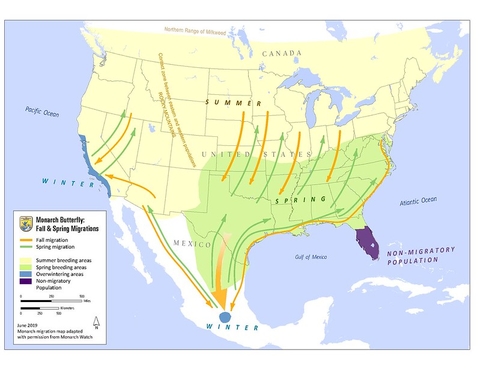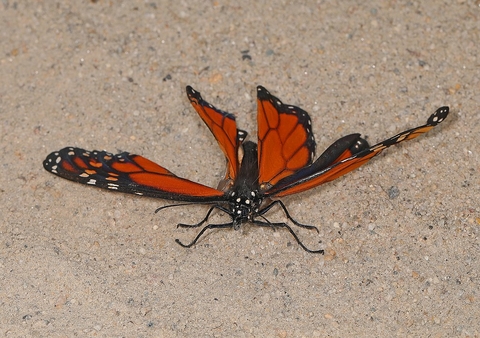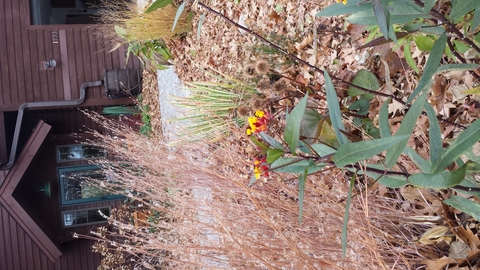With sobering news about monarch butterfly (Danaus plexippus) populations, many gardeners are intent on growing more habitat for these interesting creatures. One type of milkweed advertised to support monarchs—called tropical milkweed (Asclepias curassavica)—has a complex and likely negative impact on the butterflies.
Tropical milkweed
Tropical milkweed is thought to be native to the Caribbean and Central America. Evergreen in very warm climates like Florida, you can still grow this Zone 8-11 plant as a tender annual further north. This plant produces very attractive orange and blood-red flowers, whose closest lookalike is the native butterfly milkweed (Asclepias tuberosa). While originally intended as an ornamental plant, there is evidence tropical milkweed can escape and become a weed in suitable climates.
Pollinator groups such as the Xerces Society, as well as scientists who study monarchs are worried about several features of tropical milkweed. Unlike the invasive black swallow-wort vine (Vincetoxicum nigrum) that was in the news a few years ago, a monarch can fully complete its life cycle on a tropical milkweed. The plant is highly attractive to adult butterflies and provides ample food resources for caterpillars.
Monarch migration effects
All this seems like it would be great for monarchs, but the reality is more complicated. Unlike most native milkweeds, tropical milkweed does not go dormant during the fall or winter. As long as it is warm outside, it will continue to chug along, attracting butterflies. While not completely understood, tropical milkweed is linked to monarchs ditching their normal fall migration to Mexico — one of the longest by any insect.
Minnesota’s monarchs move down to their overwintering sites in Mexico in only one generation. During this time, adults go through something called reproductive diapause. This fancy phrase just means their biology does not allow them to mate.
This makes sense, as the adult butterflies need every ounce of energy to make the journey. If tropical milkweed snaps them out of their diapause, they lay eggs instead and do not migrate further south.
This is a particular concern in places like Oklahoma, Texas, and Kansas, where tropical milkweed can last longer into the year. If a cold snap occurs, any eggs, adults or caterpillars on the tropical milkweed will not survive. This is exactly what happened in 2019, as Oklahoma scientists observed the aftermath firsthand.
Disease concerns
Another concern about tropical milkweed is indirectly related to migration. Tropical milkweed has a very high concentration of a plant chemical called cardenolides. Milkweeds produce this to repel animals which could feed on it. Monarchs use cardenolides and repurpose it to make themselves toxic to predators.
At high enough levels in the monarch’s body, cardenolides also seem to suppress a parasite called OE (Ophryocystis elektroscirrha). OE is spread by spores and can cause the adult monarch’s wings to become deformed. In severe cases, OE can cause death. A 2010 Emory University paper saw evidence that OE-infested monarchs may purposely lay eggs on higher toxin plants like tropical milkweeds. If their offspring happened to catch OE too—which was likely—then eating the tropical milkweed could help them survive.
Why would tropical milkweed be the bad guy if it is helping butterflies avoid death by OE? The real worry is that a monarch who is only “sort of” sick with OE can spread this damaging disease more widely than if it died.
To illustrate how, let’s assume there is a Texas monarch, sick with OE, that lays her eggs on a tropical milkweed. As the butterfly moves about, she also happens to shed spores onto the plant. After eating spore covered material, her caterpillars become infected with OE. But, thanks to tropical milkweed’s “medicine,” the caterpillars make it to adulthood. These still contagious survivors then turn into non-migratory butterflies, perhaps due to tropical milkweed’s effects. Instead of heading south, these Texans stay put in Texas.
Eventually, the Texas monarchs encounter migratory Minnesota butterflies on their way to Mexico. These Minnesotan monarchs do not have a lot of illnesses, including OE, because the sick ones would have died earlier in their migration. But by physically interacting, perhaps on an attractive tropical milkweed, the Texan monarchs can get the healthy Minnesotans covered in OE spores.This hypothetical example is unfortunately close to reality, according to a 2018 multi-university study. In short, tropical milkweed can get a ton of visitors on their flowers who do not like to leave, which helps spread diseases like OE and hurts monarch migration.
Alternatives to tropical milkweed
So what can we do in Minnesota? Unlike other states directly to our south, the risks from tropical milkweed are less clear because we have a cooler climate than Texas or Oklahoma. How widespread do people plant it here? Would it make our butterflies non-migratory too? How attractive would tropical milkweed be to a Minnesota butterfly in the late summer/early fall?
Extension horticulture educator, Julie Weisenhorn, was able to snap a photo of a Minnesota planted tropical milkweed blooming in November. This should give us pause about planting more of them in our state.
With warmer winters likely for Minnesota, it is best simply not to plant tropical milkweed to avoid the chance of any making it to spring. Some newer research suggests that tropical milkweed might even get worse as a monarch food as the climate warms.
If you or someone you know is tempted to plant tropical milkweed, be mindful about why. Is it because of the colors? Is it because it is an easy to grow annual flower? Or do you simply want a “weird” milkweed that monarchs like? By contacting a Master Gardener, calling your local Extension office, or visiting a research-based organization like the Monarch Joint Venture, you can choose alternatives that do not have the baggage and unknowns of tropical milkweed.
Here are some alternatives for tropical milkweed:
- Yarrow (Achillea millifolium) - Native species; perennial; cultivars feature yellow, red, pink, or white flowers. Drought tolerant.
- Zinnia (Zinnia elegans) - Annual; available in a wide variety of colors, sizes. Open flower forms are best for pollinators.
- Sunflowers (Helianthus annuus) - Annual; ‘Music Box Mix’ is a favorite multi-branched, semi-compact variety of Julie’s. Choose sunflowers that are not sterile and provide pollen.
- Orange Fudge black-eyed Susan (Rudbeckia ‘Orange Fudge’) - Annual; robust and floriferous plant with red-orange flower gradations.
- Sneezeweeds (Helenium) - Perennials and annuals; many varieties, lots of flower colors. (yellow, yellow / red-orange, copper-colored). Drought tolerant.
- Butter daisy (Melampodium) - Annual with many gold flowers.
- Tickseed (Coreopsis) - Perennial; various species with gold and red flowers.
- Blanket flower (Gaillardia) - Native short-lived perennial; red and yellow flowers.
You can check out our annual flowers page for more details about pollinator friendly annuals. We also have a great page for general butterfly gardens as well. If you are primarily interested in monarch butterfly habitat, choose from some of our state’s native milkweeds listed by Minnesota Wildflowers.
- Altizer, S. M., Oberhauser, K. S., & Brower, L. P. (2000). Associations between host migration and the prevalence of a protozoan parasite in natural populations of adult monarch butterflies. Ecological Entomology, 25(2), 125-139. https://resjournals.onlinelibrary.wiley.com/doi/abs/10.1046/j.1365-2311.2000.00246.x
- Altizer, S., Oberhauser, K., Satterfield, D., and Sarikonda,C. (2015). “Q&A about research related to tropical milkweed and monarch parasites”. Monarch Joint Venture. https://monarchjointventure.org/blog/qa-about-research-related-to-tropical-milkweed-and-monarch-parasites
- Altizier S., Satterfield, D., Oberhauser, K., Brower, L., Caldwell, W., and Nail, K. “Potential risks of growing exotic (non-native) milkweeds for monarchs”. Monarch Joint Venture. https://mjv.nyc3.cdn.digitaloceanspaces.com/documents/mjv_fact_sheet.pdf
- Chayka, K. and Dziuk, P. (2023). “Asclepias“. Minnesota Wildflowers. https://www.minnesotawildflowers.info/search?kw=asclepias
- Clement, K. A., and Crawford, P. H. (2020). Fall available tropical milkweed (Asclepias curassavica L.) may be a population sink for the monarch butterfly. Oklahoma Native Plant Record, 20(1). https://ojs.library.okstate.edu/osu/index.php/ONPR/article/view/8322
- Faldyn, M., Hunter, M., and Elderd, B. (2018). Climate change and an invasive, tropical milkweed. Ecology (Durham), 99(5), 1031-1038. https://esajournals.onlinelibrary.wiley.com/doi/full/10.1002/ecy.2198
- Jepsen, S. (2023). “Troubling News for Eastern Monarchs as Overwintering Area Declines”. Xerces Society. https://xerces.org/press/troubling-news-for-eastern-monarchs-as-overwintering-area-declines
- Lefèvre, T., Oliver, L., Hunter, M. D., & De Roode, J. C. (2010). Evidence for trans‐generational medication in nature. Ecology letters, 13(12), 1485-1493. https://onlinelibrary.wiley.com/doi/abs/10.1111/j.1461-0248.2010.01537.x




